Hyrule Warriors (Wii U) Review
By SirLink  20.09.2014
20.09.2014

Although Hyrule Warriors wasn't the first of Nintendo's new wave of crossover projects with Third Party companies to be announced - that honour goes to Shin Megami Tensei X Fire Emblem - it is the first one to come out and it sure has come a long way since its rather underwhelming reveal less than a year ago. As a mix between The Legend of Zelda and Dynasty Warriors from Koei Tecmo, it was originally intended to be much closer to a regular Zelda game, but that idea was shot down by Shigeru Miyamoto himself in favour of a title that plays like Dynasty Warriors with the style and some minor elements of The Legend of Zelda. The decision has certainly paid off, as the final product is its own thing that doesn't try to emulate something it's not. Instead, the developer took the Dynasty Warriors formula it had plenty of experience with and lovingly added elements from the legendary Nintendo franchise to it.
In many ways, it feels like an official fan game that provides the perfect setup for an experience that's simply not possible in a main Zelda instalment. While the countless nods and references are sure to delight Zelda fans, how does the Dynasty Warriors gameplay hold up from the perspective of someone who is only familiar with the former? Read on to find out…
The story features recurring characters such as Link, Zelda and Impa, as well as some others that originate from three particular Zelda games, being Ocarina of Time, Twilight Princess and Skyward Sword. It goes without saying that the story of a crossover like this is not canon, although that likely won't deter enthusiasts from trying to figure out how it could possibly relate to the official timeline of the series. The visual presentation is top notch, with the major cut-scenes setting high expectations for the main Zelda title heading to the Wii U next year. It should be mentioned, however, that the dialogue - much like regular Zelda games - is not voice acted. It's certainly debatable whether the series should adopt voice acting or not, but if it did, a spin-off title not developed by Nintendo itself is definitely not where it should be introduced. That said, the intermissions between scenarios are narrated impressively.
Each chapter of the campaign can be replayed with all the cut-scenes in Legend Mode or any unlocked character in Free Mode, but the real replay value comes from the meaty Adventure Mode that takes place on the overworld map of the original The Legend of Zelda on the NES. Each square is tied to a specific challenge that takes elements from the main game and mixes them up. This mode can be accessed while playing through the story for a change of pace, but it's also a really good way to level up, gather materials and obtain better weapons. Each challenge grades the player based on number of KOs, time, and damage taken, and specific ranks are necessary to unlock surrounding squares of the map or extra rewards.
Some of them also award item cards that can be used on specific tiles to uncover secrets that unlock additional rewards, such as more powerful weapons. These secrets are often based on ones found in the original The Legend of Zelda, rewarding dedicated fans that already know them. Those who don't know or remember the secret spots have to use compass cards to discover the suspicious tile or simply opt for a trial and error approach. There is a lot of content on offer here and it gets quite difficult further in, too, with most of it clearly intended to be tackled after completing the campaign.
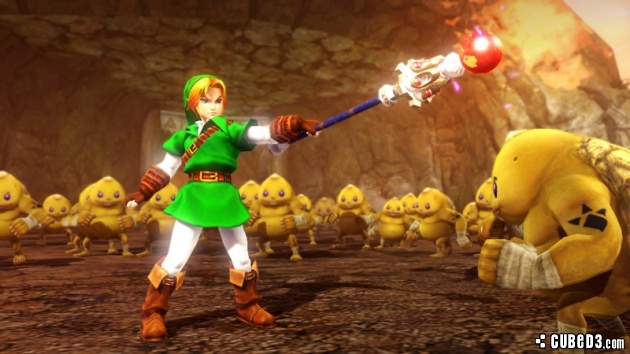
The combat is fast-paced and very satisfying, with three of the face buttons dedicated to attacking. Regular attacks are mapped to the B button, which can then be chained into a more powerful combo with the Y button where the variety that is performed depends on when the regular combo is changed up. Pressing X triggers a powerful special attack that's capable of wiping out many foes at once while the A button is for dodging. The lock-on system from the 3D Zelda games is available, too, making it far easier to keep track of a difficult adversary in the heat of battle. There is also an alternative control scheme that changes the face button layout to what Dynasty Warriors fans will be more accustomed to.
Although the number of playable characters is rather small, each of them feels unique and has a different additional mechanic. For example, Zelda with her Rapier can charge up to three orbs of magical energy that change her finishing moves, while Sheik can play songs that act as temporary buffs or additional attacks. Switching between characters makes the experience a far more enjoyable one, as they all come with their own play style. There are also some characters with multiple weapon types that come with completely different move sets to give the combat even more variety.
In addition to the thousands of grunts that are really just cannon fodder, the enemy selection includes elites that require more effort to take down and a decent amount of bosses. All special foes have certain moves after which they leave themselves open, causing a Weak Point Gauge to appear. Attacking them to fully deplete that gauge triggers a powerful Weak Point Smash that differs for each character. Familiar items such as bombs or boomerang also make an appearance and can temporarily be upgraded for additional power and effects. By far the best item is the upgraded bombs that are massive and can be thrown fairly quickly to cause insane destruction. Although normal combat already feels very empowering, things like this definitely take it to the next level. The same could be said about the Focus Spirit power, which can be triggered after collecting enough magic bottles. It temporarily increases the damage and speed of the fighter while making them immune to staggering, and is a deadly tool in the right hands, as racking up more kills extends the time and grants a number of bonus effects, such as more dropped hearts, materials or weapons. On top of all that, once Focus Spirit runs out, the character performs a powerful finishing blow that covers a wide area. Alternatively, the mode can be cancelled manually to perform a different special move that covers a smaller area but causes the Weak Point Gauge of hit targets to appear to make up for it.
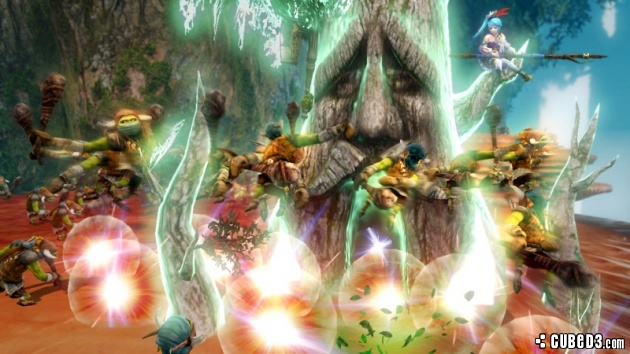
It may not be obvious based on released trailers, but there is more to the battles than mere combat. Each faction typically has a base and the maps contain a number of keeps and outposts that spawn reinforcements if captured. Doing so is important to control the battlefield, which is something that's far more necessary on the harder difficulties. Each keep has a meter that will go down with every defeated unit inside it. Once depleted, a keep boss needs to be defeated in order to conquer it. Claiming a keep triggers a shockwave that sends all opposing forces flying and finishes off most grunts. It's a rather small detail, but it's surprising just how much more satisfying it is to take keeps because of it.
Allied troops fight their own battles across the map and are often led by the other main characters or generic captains. They can take care of themselves to a degree and mainly struggle fending off elite enemies or bosses. If the health of the leaders is depleted, they will flee for the remainder of the scenario. Although the player is much like a one-man army, it's naturally not possible to be everywhere at once, so it's necessary to help out regularly and rescue severely weakened characters before it's too late. In some cases, letting an important ally be forced to flee can cause the mission to fail, but more often than not the fall of the allied base is part of the defeat conditions. Speaking of which, a failed scenario can be restarted from the latest checkpoint or a previously set save point. Restarting it completely or going back to the title screen will also retain all experience that was earned during the chapter.
These mechanics add a lot to the gameplay and really start to shine in harder scenarios where efficiency and strategy is extremely important. For example, ignoring attacks on the allied base for too long can prove to be fatal later on if the main battle moves there. Of course, the enemies also hit much harder, are more aggressive, and generally allow a lot less mistakes or mindless button mashing. The morale of both allied and opposing troops has to be considered, too, as it's determined by how well the battle is going for the respective faction. For example, losing a crucial keep can motivate the opposition and give some or even all of their soldiers a power boost. It's extremely satisfying to win a battle against all odds and there is plenty of that to be found on the harder difficulties. The lower difficulties are ideal for those who prefer an easy time and just want to enjoy the spectacle or story. It does, however, make these extra mechanics a lot less significant because scenarios can be won without paying too much attention to anything other than the main objectives required to win.
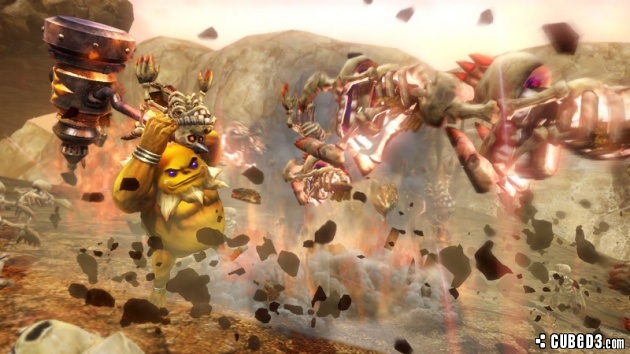
There are three aspects that determine the performance of each character. Their level affects power and health, while better weapons significantly increase attack power in addition to providing helpful offensive or support skills, which can be transferred to other ones that possess free slots in the Smithy. Lastly, it's possible to craft badges with materials gained from defeating enemies and bosses. The badges expand the move set of weapon types and provide a number of passive enhancements, such as dealing more damage to guarding foes. Not all characters require the same materials for the same badges, making it a bit easier to switch between them. There is also a Training Dojo to level up any of them that may have fallen behind in levels along the way in exchange for a sum of Rupees.
Although each scenario has clear objectives, there is no shortage of collectibles in Hyrule Warriors. Taking keeps that are a bit out of the way or tough to get to can cause chests to spawn that contain either a Piece of Heart of a full Heart Container, but only for specific characters. Thankfully, each chapter or stage in Adventure Mode clearly lists what can be found in advance. The famous Golden Skulltulas also make an appearance and tracking them down is rewarded with a piece of one of several illustrations. Unlike the other type of collectible, many of them can be gotten with any character. Their spawn requirement is usually achieving 1,000 KOs in a level, after which they will appear on the battlefield somewhere within the reach of a giant spider web displayed on the map. Killing certain amounts of them also enhances the effects of potions and additional buffs that can be obtained by using up leftover materials at the Bazaar.
The game can be played with the GamePad (Off-TV mode included), a Pro controller, or a Wii Remote and Nunchuck combo. The GamePad screen can be quite useful for faster item switching than with the D-pad, as well as keeping track of the health bars of allies and recent missions without having to pause the game to go into a sub menu. An optional co-operative mode is also available, where one player uses the GamePad screen and the other the TV with one of the other two supported controllers.
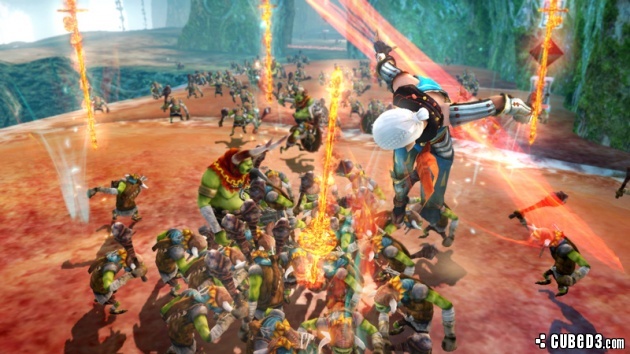
Cubed3 Rating
Exceptional - Gold Award
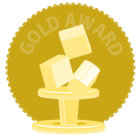
Hyrule Warriors is an outstanding crossover of The Legend of Zelda and Dynasty Warriors with addictive gameplay, a slick presentation, and a lot of content. In fact, the mix of the two series works so well that it has to be wondered why it took this long to materialise. Few franchises boast a legacy that matches The Legend of Zelda and it's a joy to play as characters other than Link after all this time, giving them a well-deserved spot in the limelight. Those familiar with Warriors games (like Warriors Orochi 3 Hyper, also on Wii U) will know what to expect, while Zelda fans should definitely consider giving this game a try, as long as they don't go in expecting it to be like a regular Zelda instalment. What Hyrule Warriors is, though, is a highly enjoyable spin-off that's filled with all sorts of fan service, which might just be the best way to ease the wait for the next mainline The Legend of Zelda game coming to the Nintendo Wii U next year.
Comments
Comments are currently disabled

 Sign In
Sign In Game Details
Game Details
 Out now
Out now  Out now
Out now  Out now
Out now  Out now Also on
Out now Also on 
 Subscribe to this topic
Subscribe to this topic Features
Features





 Top
Top

